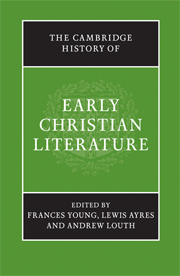Book contents
- Frontmatter
- PART ONE The Beginnings: The New Testament to Irenaeus
- PART TWO THE THIRD CENTURY
- A LITERARY GUIDE
- 11 The Alexandrians
- 12 The beginnings of Latin Christian literature
- 13 Hippolytus, Ps.-Hippolytus and the early canons
- 14 Cyprian and Novatian
- 15 The earliest Syriac literature
- 16 Concluding review: the literary culture of the third century
- B CONTEXT AND INTERPRETATION
- PART THREE FOUNDATION OF A NEW CULTURE: FROM DIOCLETIAN TO CYRIL
- Bibliographies
- Index
- Map: The Roman Empire in the late fourth century AD"
- References
14 - Cyprian and Novatian
from A - LITERARY GUIDE
Published online by Cambridge University Press: 28 March 2008
- Frontmatter
- PART ONE The Beginnings: The New Testament to Irenaeus
- PART TWO THE THIRD CENTURY
- A LITERARY GUIDE
- 11 The Alexandrians
- 12 The beginnings of Latin Christian literature
- 13 Hippolytus, Ps.-Hippolytus and the early canons
- 14 Cyprian and Novatian
- 15 The earliest Syriac literature
- 16 Concluding review: the literary culture of the third century
- B CONTEXT AND INTERPRETATION
- PART THREE FOUNDATION OF A NEW CULTURE: FROM DIOCLETIAN TO CYRIL
- Bibliographies
- Index
- Map: The Roman Empire in the late fourth century AD"
- References
Summary
Much of the mid-third century is scantily documented for both secular and Church history. We are fortunate, however, to have an abundance of material concerning Cyprian and the church in Carthage for the ten-year period from May 248 to September 258. All of Cyprian’s twelve, or thirteen, treatises have survived, plus eighty-two letters from his extensive correspondence. There are, in addition, a Vita Cypriani written shortly after Cyprian’s death by his deacon, Pontius, and the Acta Proconsularia Cypriani.
Our sources, however, are almost exclusively concerned with Cyprian’s career as bishop. We know nothing certain about his birth or family. From references to his property, gifts, and the social status of some of his friends, it is assumed that he came from a Carthaginian family of wealth and rank. C. A. Bobertz has argued that he belonged to the social strata of municipal decuriones. Jerome says that he had taught rhetoric before his conversion by the presbyter Caecilius (Vir. Ill. 67). The date of his conversion (245–6) is also a matter of conjecture. Cyprian describes his conversion in the Ad Donatum, but in a general and ‘rhetorically stylized’ way.
- Type
- Chapter
- Information
- The Cambridge History of Early Christian Literature , pp. 152 - 160Publisher: Cambridge University PressPrint publication year: 2004
References
- 2
- Cited by



